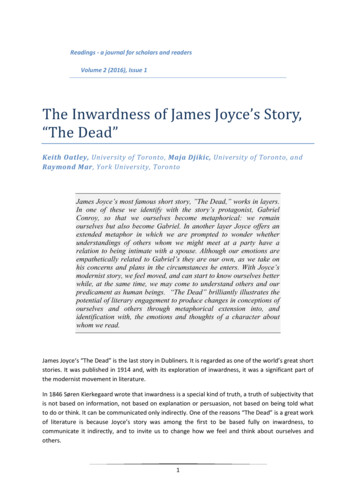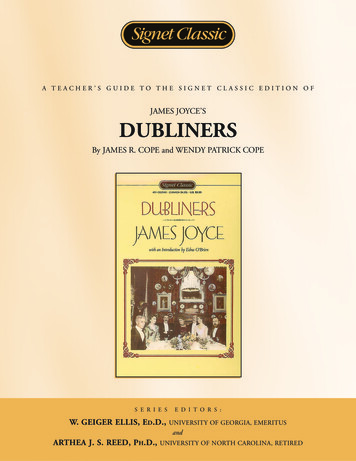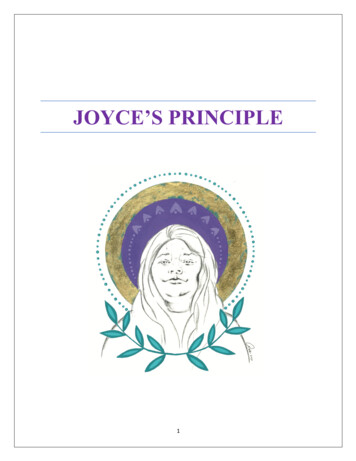
Transcription
Readings - a journal for scholars and readersVolume 2 (2016), Issue 1The Inwardness of James Joyce’s Story,“The Dead”Keith Oatley, University of Toronto, Maja Djikic, University of Toronto, andRaymond Mar, York University, TorontoJames Joyce’s most famous short story, ”The Dead,” works in layers.In one of these we identify with the story’s protagonist, GabrielConroy, so that we ourselves become metaphorical: we remainourselves but also become Gabriel. In another layer Joyce offers anextended metaphor in which we are prompted to wonder whetherunderstandings of others whom we might meet at a party have arelation to being intimate with a spouse. Although our emotions areempathetically related to Gabriel’s they are our own, as we take onhis concerns and plans in the circumstances he enters. With Joyce’smodernist story, we feel moved, and can start to know ourselves betterwhile, at the same time, we may come to understand others and ourpredicament as human beings. “The Dead” brilliantly illustrates thepotential of literary engagement to produce changes in conceptions ofourselves and others through metaphorical extension into, andidentification with, the emotions and thoughts of a character aboutwhom we read.James Joyce‘s “The Dead” is the last story in Dubliners. It is regarded as one of the world’s great shortstories. It was published in 1914 and, with its exploration of inwardness, it was a significant part ofthe modernist movement in literature.In 1846 Søren Kierkegaard wrote that inwardness is a special kind of truth, a truth of subjectivity thatis not based on information, not based on explanation or persuasion, not based on being told whatto do or think. It can be communicated only indirectly. One of the reasons “The Dead” is a great workof literature is because Joyce’s story was among the first to be based fully on inwardness, tocommunicate it indirectly, and to invite us to change how we feel and think about ourselves andothers.1
Oatley, Keith; Djikic, Maja; Mar, Raymond. "The Inwardness of James Joyce’s Story, “The Dead”".Readings 2.1 (2016)The main character in “The Dead” is Gabriel Conroy. He and his wife, Gretta, attend a Christmas partygiven by his two elderly aunts and his cousin, who are music teachers in Dublin. The first and longestpart of the story depicts the arrival of Gabriel at the house where the party is held, Gabriel’semotions and thoughts as he talks with people there, and his speech of thanks to his aunts andcousin. The story’s middle section is a transition: as guests leave the house, Gabriel watches Grettaas she stands at the top of the stairs and listens to someone singing an Irish song, “The lass ofAughrim.” Gabriel notices his wife’s poise and thinks that if he were a painter he would paint her andcall the picture “Distant music.” He recalls moments of their secret intimacy. The last section of thestory takes place in a hotel. Gretta has arranged for their children to be looked after and Gabriel hasbooked into the hotel for the night because the late journey home after the party would be difficult.In the hotel room, he wants to relive his intimacy with Gretta and make love with her. For a momentit seems as if this will happen, but she breaks away, throws herself on the bed, and hides her face.Gretta tells Gabriel that the song, “The lass of Aughrim,” was one that a delicate seventeen-year-old,Michael Furey, used to sing when she was young, in Galway in the west of Ireland. On the nightbefore she was due to leave and come to Dublin, Michael threw gravel up at her window. He hadbeen ill but he was there in the garden, shivering, in the pouring rain in the middle of winter. Grettasays she told him to go home or he would catch his death of cold. A week after she arrived in Dublin,she heard he had died. She thinks he died for her.Gretta sobs, and falls asleep. Gabriel looks at his wife’s clothes thrown on a chair, notices herpetticoat. He lies on the bed beside her as she sleeps. He thinks about how, for so many years, shehas kept in her heart the memory of Michael Furey. Gabriel realizes for the first time that he is notthe only one she has loved. She has been occupied with her thoughts of this boy and herself whenthey were young: Gabriel is devastated at not being able to make love with her, and horribly jealous.He thinks that Michael Furey was capable of more love than he has been and that maybe it would bebetter to die, like the young boy, in a passion that completely occupied his being.A layer of ostranenie, metaphor and metonymyAround the time that Joyce published his story, Viktor Shklovsky was working on how artisticliterature can make the ordinary strange, as if seen for the first time. He called this ostranenie,“defamiliarization:” the freeing of experience from deadening effects of habit to make it conscious.Many of us may have experienced jealousy. Perhaps it was a twinge, perhaps a wave of anxiety,perhaps anger, perhaps a long dull pain. But no-one—we think in Western literature, notShakespeare in Othello, not Tolstoy in “The Kreutzer Sonata” —has depicted it, step-by-step, in itsdevelopment in such an ostranenie way as Joyce does in this story. The arc of emotion is beautifullycommunicated through a progression of scenes: Gabriel’s idealization of Gretta as she listens to asong; his thoughts of “moments of their life together that no one knew of or would ever know of;”her leaning on his arm in a way that sent “through him a keen pang of lust”; in the hotel room Grettarising on her toes to kiss him but then throwing herself face-down on the bed, not thinking aboutmaking love with him; her story about Michael Furey; her saying “I was great with him at that time;”Gabriel’s thought that “a man had died for her sake.”At the same time, Joyce generates further ostranenie by using metaphor and metonymy. As RomanJakobson pointed out, these literary figures are not just figures. They are fundamental ways in whichthe mind works and they are also parts of what can enable the experience of reading to come alive.2
Oatley, Keith; Djikic, Maja; Mar, Raymond. "The Inwardness of James Joyce’s Story, “The Dead”".Readings 2.1 (2016)Although Lakoff and Johnson have argued that metaphor is an intrinsic part of all of our thinking, it isusually regarded as literary. An example occurs when Hamlet says: “Denmark’s a prison”(Shakespeare, 1600, Act II, Scene ii, line 243). For him a “this,” Denmark, is a “that,” a prison. He’s ina situation from which he cannot escape. According to Steven Mithen, minds can work in ametaphorical way not only in literature; rather, metaphor is the basis of all art. The earliest knowncave painting is only 31,000 years old (see Chauvet et al.’s book). In the painting, marks on a rock (a“this”) become a rhinoceros (a “that”). To be able to produce and understand art based onimagination, in this kind of metaphorical transformation, is among our most recently acquired mentalcapacities.Literary metaphors can be written in a phrase such as “Denmark’s a prison,” compacted, ready toburst on a reader or listener. In “The Dead,” Joyce tends to avoid compacted metaphors. In fact, hemakes fun of them in the story’s first sentence, when he says that Lily, the caretaker’s daughter whois taking the coats of guests, “was literally run off her feet.” But Joyce’s story can be thought of as anextended metaphor. By arranging that the story opens at his aunts’ house, then moves to its finalphase in the hotel room, he invites us to project a “this,” the togetherness of a family party, onto a“that,” the togetherness of a couple’s marriage. Are the difficulties of interacting, at a party, withother people whose minds we don’t know, to be compared with those of achieving intimacy with aspouse whose mind we might also not know?Whereas in metaphor a “this” is a “that,” in metonymy, Jakobson said, a “this” is juxtaposed with a“that” or is part of a “that.” In The Modes of Modern Writing, David Lodge has argued that whereasmetaphor has been the usual mode for poetry and plays, metonymy is a predominant structure ofmodern print fiction and film. In "Metonymy and Intimacy," Rebecca Wells-Jopling and Keith Oatleyhave shown that with a metonym the writer hopes that an association in his or her mind, signaled bya juxtaposition, will prompt a comparable association in the reader. When this happens, it makes fora sense of mental intimacy between reader and writer.The best-known kind of metonymy is synecdoche, in which a part stands for a whole, or a small partfor a larger part. For instance, a close-up of a face in a film can stand in for the person. In “The Dead,”it occurs when Gabriel is introduced on the story’s fourth page as looking “stout with gilt rimmedglasses.” These are indicative parts of the man as a whole.Like metaphor, metonymy is not just a figure. It, too, shows something important about how themind works. In the hands of an artistic writer it can work in a way that is profound, and Joyceaccomplishes this in “The Dead.” The glimpse of Gabriel as stout with gilt-rimmed glasses mayprompt reservations about him. When the couple reaches the hotel there is another metonymicsynecdoche when Gabriel, as he longs to make love with Gretta, catches sight of himself in a mirror:not a romantic figure. There’s an association between this partial glimpse of Gabriel as he lookscompared with the larger way in which he likes to think of himself. This can resonate withassociations in readers, who may be prompted to think about how they look in the mirror of theirsocial world and how they like to see themselves.A layer of identificationMetaphor offers part of the explanation of how we become involved in a story by entering, Alice-like,through a looking glass. As we enter a story, it is common for readers to identify with a character.3
Oatley, Keith; Djikic, Maja; Mar, Raymond. "The Inwardness of James Joyce’s Story, “The Dead”".Readings 2.1 (2016)This means that we take on a protagonist’s aspirations and concerns. (Keith Oatley: Such stuff asdreams). The mental processes we employ include those by which we make plans to organize ourdaily lives but, instead of using these planning processes for our own purposes, we allow them to betaken up by the purposes and aspirations of a story character. When we pick up a book and startengaging with plans of the protagonist, we put our own issues on one side rather as someone who,before beginning a session of meditation, puts aside current preoccupations.In this kind of way, in “The Dead,” a change can occur: we ourselves become metaphorical. Weremain ourselves (the “this”), and empathetically we can also become Gabriel Conroy (the “that”).Here is the extraordinary part: the emotions we then feel as we read are not really those of Gabriel(an imagined being). They are our own.An important study on how this works was by Tom Trabasso and Jennifer Chung. They found thatwhen we enter a story and things go well for a protagonist whom we come to like, we feel empathyfor that character and experience positive emotions: happiness, satisfaction, relief and so on. Whenthings go badly for the protagonist, or well for an antagonist in a story, we tend to feel negativeemotions: sadness, anxiety, frustration, and so forth. There has not been much research on this sofar (though see Jonathan Cohen, “Defining identification,” Maria Kotovych et al. “Textualdeterminants,” and Emy Koopman, “Empathetic reactions after reading”) but the implication is thatidentification is empathy, or that it involves empathy.This, you may say, is not too different from watching sports. When your team is winning you feelgood. When the other side is winning you feel bad. That’s right. It isn’t too different. This is because afootball match or an Olympic competition offers a basic kind of plan-based story; we can jumpaboard and enjoy it. We can experience the emotions of success or failure, but without the eventsmaking a difference to whether we can pay the rent, or to whether someone we love might beseriously ill. A football match and a hundred-metre race are, of course, different from “The Dead,”but they have something in common. They offer us an aspiration, an idea of overcoming vicissitudes,in which we take part in imagination (Keith Oatley, “Worlds of the Possible”). The plots of sportsevents are not very various, but they can be engaging: we win, we lose, we would have won if wehadn’t made that mistake or if it hadn’t been for the bias of the referee. In literature, the stories inwhich we can engage are more various.The characters we can become in fiction are many more than we can be in sports events, many morethan we could ever be, or ever meet, in ordinary life. By entering some of the novels and shortstories that have been written, and the movies that have been made, we can live many lives; theplans we can adopt and the predicaments we can experience are innumerable.A layer of characterMost stories have a narrative arc: an initiating event that introduces a protagonist who has a goaland a plan that encounters a vicissitude. There is a rising action, a climax, and a denouement. Joyce’sstory has some of these properties, but its arc is psychological. Virginia Woolf wrote that: ”in orabout December, 1910, human character changed” (p. 320). She was referring to the coming ofmodernism, which we can think of as the art of inwardness. With this story of 1914, Joyce was anearly contributor. We are introduced to a character, Gabriel, in an inward way by his thoughts abouthimself and his experience being gradually revealed to us until we reach a psychological climax, one4
Oatley, Keith; Djikic, Maja; Mar, Raymond. "The Inwardness of James Joyce’s Story, “The Dead”".Readings 2.1 (2016)that opens him to us, to show both the complexity and limitations of his person and, by thegeneralization of a metonymic figure, of all of us.A psychological question for any story is how it invites a reader into its world. Joyce does it bydropping hints and by inviting the reader to think. When the story begins we hear of Miss Kate andMiss Julia, but we have no idea how to imagine them. Are they young, old, sisters, friends? Joycekeeps us wondering for a while. How can we construct the scene with which we are presented, withguests arriving, and with Miss Kate and Miss Julia at the top of a staircase? At the beginning of hisstory, Joyce refers to characters who are only later positioned in relation to the others. Someonecalled Gabriel is mentioned in the third paragraph. Only later do we find out who he is and what helooks like. Although sometimes thinking can be arduous, with a good writer of fiction, it is a delight,in part because the writer offers materials that enable the thinking to occur in a satisfying way. MariaKotovych and her colleagues showed that in a short story by Alice Munro, when the reader wasinvited to make inferences about a character in the way we make them in conversation (as Munrodepicts), the understanding and identification with the character was deeper than when phrases thatexplicitly named emotions and character traits such as “she was embarrassed” were substituted forMunro’s words.Once Joyce has invited us to become engaged, he eases us into the process of coming to understandGabriel. Edward Royzman and Paul Rozin found that when you don’t know someone very well, it iseasier to empathize with them if they are in difficulties. To be pleased about their success, you needto know them quite well, and to like them. At the beginning of the story, we don’t know Gabriel. Thefirst significant event occurs as Lily takes his coat when he arrives at the house. Gabriel has knownLily since she was a child. He speaks to her pleasantly. He asks whether she might soon be gettingmarried. She replies bitterly that men are interested in her only for what they can get. So, with Lily,he’s in difficulties immediately. He colors. He feels he has made a mistake. He flicks at his shoes withhis muffler. He leaves Lily a coin, then dashes up the stairs. We readers are invited to think not aboutthe event, but about Gabriel’s reaction to it, to ponder why he should polish his shoes with a muffler.We empathize with him and enter his mind. Joyce goes along with us as we puzzle. He says thatGabriel feels he has failed with Lily. He says Gabriel adjusts his clothing: we infer this is to help dispelhis anxiety. Joyce also offers a generalization. Gabriel worries that he will fail in the speech he mustgive in thanks to his aunts and cousin, just as he has failed with Lily.Several elements in the story make sense because they help the reader to understand Gabriel. Thereis, for example, a mention of Gabriel’s mother and how she sullenly opposed his marriage to Gretta.In the same way we read about his love for the physicality of books. These details seem not to relateto the plot of story, but they contribute to our understanding of Gabriel.Gabriel is patterned on James Joyce himself. Richard Ellmann devotes a chapter of his biography ofJoyce to the background for “The Dead.” He shows how Joyce shared with Gabriel not justattendance at Christmas parties given by his aunts who lived in a house on a quay beside the RiverLiffey (in Joyce’s case they were great-aunts), but other aspects such as a wife who had come fromGalway, intense sexuality, and ready jealousy. The reader engages with realities that Joyce knewwithin himself and had thought about deeply.5
Oatley, Keith; Djikic, Maja; Mar, Raymond. "The Inwardness of James Joyce’s Story, “The Dead”".Readings 2.1 (2016)Character remains, perhaps, more important than anything else in fiction. If you are not engagedwith at least one character in a story, you tend not to continue. The psychological origin is deep andhas only recently become clearer. It used to be thought that the reason we humans had larger brainsthan other animals was because we were very clever, because we could make tools, or were cunningat hunting. But the real reason is more likely to be that we are the most social of all the animals. AsRobin Dunbar has proposed, we need large brains because we know a large number of people in oursocial world, up to about 150 or so, in sufficient detail that we can describe something of thecharacter of each of them. We make mental models of them, for instance: “Fred is amiable, but Iwish he wouldn’t grumble all the time.” The maximum size of social group in which our closestanimal relatives, the chimpanzees, live is 50. That is to say 50 individuals whom each member of thegroup knows as individuals, as friends, allies, enemies. The fossil record and DNA studies show thatthe line that led to chimpanzees split off from the line that led to us about six million years ago. Thehuman brain is exceptionally large because it has to house mental models for three times as manyindividuals as can be held by the brain of a chimpanzee.As well as requiring larger brain capacity to house more mental models, our models can be highlydetailed. The people we know well, we know sufficiently not just to have an idea of the person’scharacter and not just to recall interactions we have had with that person, but also something of hisor her biography. Our models include ideas about interactions of each person with others. Dunbarhas found that about 70 percent of human conversations are about plans and doings of ourselvesand those we know. We talk and exchange anecdotes and gossip about others. From these we makeinferences about the people we talk about, and with these we supplement our mental models ofeach other: “Hetty was badly treated, you can imagine what she thinks of him now.” It is likely thatthis proclivity to converse about ourselves and others is one of the origins of our engagement infiction (see Keith Oatley, “From the emotions of conversation ”)There is a further contributor to brain size. It’s that we entertain what psychologists call theories ofmind: theories of what other people might know that is different from what we know. HeinzWimmer and Josef Perner discovered that it is not until the age of about four that children start toexperience themselves as having thoughts that are separate from those of others. The researchersread pre-school children a story in which a little boy, Maxi, has some chocolate and puts it in a bluecupboard. Maxi goes out to play and, while he is out, his mother uses some of the chocolate for acake and then puts the rest of the chocolate in a different place: in a green cupboard. The children inthe experiment were asked: “When Maxi comes back from the playground, he would like some of hischocolate. Where will he look for it?” Children under four typically said: “In the green cupboard.”That’s where they knew the chocolate to be and that’s where they thought Maxi would look. Butchildren aged four and over tended to say, “In the blue cupboard.” They knew that this is where Maxihad left his chocolate, and because he did not know that his mother had moved it, this is where hewould look. By age four children understand that other people can know things that are differentfrom what they themselves know.With theory-of-mind we not only make mental models of others, but also mental models of others’mental models (see Johnson-Laird, Mental models). Dunbar showed that we humans can maintainseveral layers of models: of what philosophers call “intentional states” for other people. Anintentional state is a mental state that is about something: seeing something, believing something,6
Oatley, Keith; Djikic, Maja; Mar, Raymond. "The Inwardness of James Joyce’s Story, “The Dead”".Readings 2.1 (2016)wanting something, feeling something. Dunbar has enumerated the layers of intentional statesrequired for certain kinds of literature. Thus, he writes (p. 162), that in Othello, Shakespeare:intended [1] that his audience realise [2] that the eponymous moor believed [3]that his servant Iago was being honest when he claimed to know [4] that hisbeloved Desdemona loved [5] Cassio.When James Joyce invites us into his story, he invites us to engage our theory-of-mind. One of thepeople at the party is a Miss Ivors, with whom Gabriel was at university. She asks if he is not G.C.whose book reviews she has read in the Daily Express. Gabriel says he is. The Daily Express is a Britishoriented paper, whereas Miss Ivors is committed to Irish independence. Other people are listening,and she says she is disappointed to find that Gabriel is a West Briton (meaning that he thinks Irelandshould remain politically part of Britain). He thinks that writing book reviews has nothing to do withpolitics, and wonders how to defend himself. Later, as they dance The Lancers, he feels Miss Ivorssqueeze his hand, then he sees her look at him quizzically, until he smiles. Then she stands on tip-toeand whispers into his ear: “West Briton.” If we use Dunbar’s notation we can say that Joyce intends[1] the reader to consider [2] what Gabriel thinks [3] Miss Ivors wants [4] Gabriel to feel [5] when shelooks quizzically at him and whispers in his ear.Joyce writes that Gabriel feels attacked, because he thinks Miss Ivors wants to make him lookridiculous in front of other people. But we readers may wonder whether she feels envious of hiswriting of book reviews for a newspaper, or whether she is teasing him affectionately. Our abilities tothink about what others may think and feel are close to the heart of being human in our intenselysocial world. If we enjoy being able to make mental models, and models of models, of fictionalcharacters, it is because—in a deep way—this is what our human brains are for (see Johnson-Laird,Mental models, Dunbar, The human story). In Why We Read Fiction, Lisa Zunshine has said we are atgood theory-of-mind, and we enjoy doing what we are good at.Gregory Currie has written: “when we engage with great literature we do not come away with moreknowledge, clarified emotions, or deeper human sympathies” (p. 15). When effects of readingliterature have been investigated in actual readers the conclusion is very different. It’s been foundthat the more fiction people read, the better they are at empathy and theory-of-mind (see RaymondMar et al. “Bookworms Versus Nerds;” Keith Oatley, “In the minds of others”). In studies by DavidKidd and Emanuele Castano, and by Jessica Black and Jennifer Barnes, the effect has been confirmedexperimentally: reading a piece of artistic fiction, as compared with a piece of non-fiction, improvedempathy and theory-of-mind. In studies that used functional Magnetic Resonance Imaging (fMRI),moreover, Raymond Mar found that several parts of the brain that are used to comprehend storiesare the same as some of the parts used for theory-of-mind, the process of understanding others.Although the word “fiction” means “something made,” this doesn’t mean it’s just made up and hasno relation to reality, as Currie’s opinion would have it. Its effects in enabling improvement ofpeople’s empathy and theory-of-mind, mean it is about something: something fundamental to ourhumanity.A deeper layer: the anguish of knowingUsually we believe that knowing others will bring us closer to them. If your friend, or lover, or eventhe greengrocer, is sad, or angry, or happy, would not understanding how this person feels bring you7
Oatley, Keith; Djikic, Maja; Mar, Raymond. "The Inwardness of James Joyce’s Story, “The Dead”".Readings 2.1 (2016)closer, help construct a bridge to that person? We would think so. Yet in Joyce’s story, as we followGabriel through his evening, with every additional instance of his coming to know someone better, orhaving someone know him, he slips further away from the very people with whom he wants to makelinks.Gabriel speaks pleasantly to Lily, and wants her to see him as gentlemanly. Instead she sees him as atypical man who thinks only about sex. This embarrasses him enough to make him blush, and insiston tipping her. He wants Miss Ivors to admire him for writing book reviews in a newspaper. Insteadshe sees him as being on the wrong political side. As he prepares his speech he thinks about hislisteners, and wants to be careful so that they think well of him. When he gives the speech, they maynot do so. When Gabriel leaves the party full of tender and passionate feelings for Gretta, it is hardfor the reader not to hope that here, finally, in the intimate space between the two of them, a deepunderstanding, a sharing of a secret life, will yield closeness. Yet here too, instead of mutuality,Gabriel finds Gretta in a different world, in which a seventeen-year-old boy has—as she supposes—died for her. He needs his wife to have loved him only. It is not so. Readers may wonder whether itmight have been better for Gabriel not to know, to have held on to an illusion of intimacy.It makes one anxious to feel with Gabriel in these instances, trying to connect through knowing, buteach time becoming more isolated. It makes us anxious in part because of what it implies abouttrying to connect. The self-improver in all of us would like to believe that if we reach out to others,learning about them will achieve closeness. Experiences of the kind Gabriel has—which we recognizeand feel in ourselves—imply this may not be so.Raymond Nickerson has studied what happens when people try to imagine what someone elseknows or thinks. His research has taken the problem of theory-of-mind from childhood intoadulthood. He has found that to understand another person we tend to project our knowledge ofourselves onto that person, whilst correcting for certain differences such as age, gender, andeducation. Projection-plus-correction works fairly well but, as Nickerson shows, usually we projecttoo much and correct too little. We tend to believe that others are more like ourselves then they are.It is not just a matter of a person’s beliefs, but of their emotions. When someone smiles, we presumean experience like our own when we smile. The assumption helps the cogs of everyday life to turnsmoothly. We would like to believe that when we say to a partner “I love you” and when the partnersays to us “I love you” that we mean the same thing. What does this imply, for Gabriel and for therest of us? It implies that knowing others needs us to understand that their experiences can bestarkly different from our own. Gabriel discovers how distant his experiences can be from those ofothers, including the person to whom he feels closest. This discovery pushes Gabriel to that edge atwhich he feels that the only commonality among human beings is that of the final outcome, a fadingtowards death.Yet to conclude that trying to get closer drives us further apart may not be right. The pivot aroundwhich misunderstanding turns in Joyce’s story is Gabriel’s need for others to see him as he seeshimself. Gabriel is not alone in this. It is an aspect of our human lot that our vision of ourselves, andthe ways in which we present ourselves to others, are constructed in part to show how we would liketo be. We do manage to live up to some aspects of our self-image, but we conceal some of the dirtiercorners. The result for Gabriel is that what he knows of others and what others know of him are8
Oatley, Keith; Djikic, Maja; Mar, Raymond. "The Inwardness of James Joyce’s Story, “The Dead”".Readings 2.1 (2016)drawn into the gravitational field of his need to see himself in a certain way. There, inevitably,differences can become threatening: where self-idealization and others’ perceptions fail to match.If literature helps us metaphorically to embody other characters within ourselves, and feel and thinkdifferently than we would otherwise, does it change us? Maja Djikic and colleagues asked people toread either Anton Chekhov’s most famous short story, “The lady with the toy dog,” or a controlversion of the story written in a non-fictional format that had exactly the same information, thatreaders liked just as well but judged to be less artistic. As c
predicament as human beings. "The Dead" brilliantly illustrates the potential of literary engagement to produce changes in conceptions of ourselves and others through metaphorical extension into, and identification with, the emotions and thoughts of a character about whom we read. James Joyces The Dead is the last story in Dubliners.










